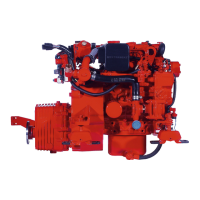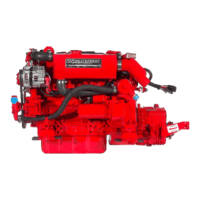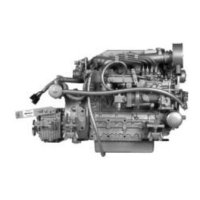LUBRICATION
SYSTEM
SERVICE
3.
Rotor
to cover clearance. With the outer rotor inserted
in
the pump body, insert a straightedge and check the clear-
ance between the rotor and the straightedge with a feeler
gauge. If excessive, replace either the rotor or the body.
ROTOR
TO
COVER
CLEARANCE
4.
Pump
body O-ring. Check the pump body O-ring for
cracks and damage.
S.
Oil
pressure switch/sender: Replace the oil pressure
switch and the oil pressure sender.
On propulsion
engines, the oil pressure switch is norma]]y open.
On
generators, this switch is normally open;
it
closes when
the oil pressure gets to
5-10 psi.
A
CAUTION:
Oil
Pressure
Switch
-
Do
not
use
lock
pliers,
vise
grips
or
pipe
wrenches
on
the
oil
pressure
switch.
Use
the
correct
socket
which
is
available
from
Snap-On,
Proto,
New
Britain
and
oth-
ers.
Damage
to
the
switch
will
cause
oil
leaks
and/or
switch
failure.
REASSEMBLY
1. Install the oil filter and tighten fully by hand. (Tightening
torque:
1.1
to 1.3 kg-m.) Before installation, check for
proper fitting
of
the O-ring
in
the groove and coat the
0-
ring with a small quantity
of
oil.
2. Install the gasket. Then install the oil pump housing,
0-
ring, rotor assembly and cover assembly
in
that order.
Apply oil to the rotating parts.
3. With sealant applied to the threaded portion, screw in the
oil pressure switch taking care not
to
close the oil hole
with sealant.
4. Apply liquid teflon sealant to the threaded portion
of
the
oil pressure sender. Take
care not to close off the oil hole
into the sender. Thread the sender into its fitting on the
oil pump's housing.
TESTING
THE
OIL
PRESSURE
1.
Start and warm up the engine.
2. Check for
oilleaks
at the filter and pump assembly.
3. Remove the oil pressure sender and connect a mechanical
oil pressure gauge to the hole.
4.
Set the engine speed at 3000 rpm and measure the oil
pressure.
It
should be fairly constant at
3.5
kg/cm2
(50
Ib/in2).
NOTE:
Insure that
oil
meets specification standards: Class
CF
or
CG-4
or
better/SAE
30
wt.
OIL
PRESSURE
SWITCH
1.
Later propulsion engines and all generators have a two-
prong oil pressure/water temperature switch. When the
oil pressure drops to
5-10 psi, this switch interrupts the
circuit for the fuel run solenoid by opening, shutting
down the engine/generator.
On early propulsion engines, this switch activates
an
alarm that emits a pulsating signal when the oil pressure
drops too low
(5-10 psi).
NOTE:
This alarm will also emit a
pulsating
signal when
the
engine starts up, as the oil
has
not
yet
reached its
normal pressure
(a
good
check
o/the
alarm).
NOTE:
If
this alarm emits a
continuous
signal (propulsion
engines
only),
it
indicates an engine overheat, with the
operating temperature reaching
210~
OIL
PRESSURE
....
+
+
t-
OIL
PRESSURE
t-
OIL
PRESSURE
'ARLY
PROPULSION
"1
ENGINE
MODELS
%
P
LATER
PROPULSION
~
ENGINE
MODELS
,ALL
GENERATOR
J
MODElS
.
OIL
PRESSURE
SWITCHES
Engines & Generators
36

